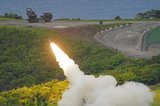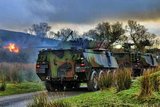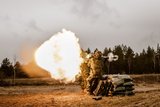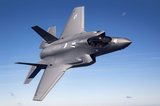China to build 'world's fastest' wind tunnel
China has announced it is building the world's fastest wind tunnel to develop a new generation of super-fast airplanes, but it could also be used for hypersonic missile technology.
Wind tunnels test how air will pass over a solid object, helping designers improve aerodynamics or reduce stress points for objects as they reach high speeds.
State-run Xinhua news agency ran a report on 19 March revealing the development of what it said would be ‘the world's fastest hypersonic wind tunnel’.
Han Guilai, a researcher with China's State Key Laboratory of High Temperature Gas Dynamics at the Chinese Academy of Sciences, reportedly said: ‘The 265m long tunnel can be used to test hypersonic aircraft that can travel at speeds of up to Mach 25, 25 times the speed of sound.’
To compare, the current fastest generation of fighter jets can travel up to speeds of around 2.5 Mach.
The revelation comes as the world's leading military nations embark on a race to develop the next generation of hypersonic weapons, from missiles and spy planes to railguns, that can beat conventional defence systems.
Earlier this month Russia's President Vladimir Putin boasted his nation had developed a new generation of ‘invincible’ hypersonic missiles in his state of the nation address, sparking anger in the US and other NATO countries.
While experts are deeply sceptical about how close to operational such a missile might actually be, US officials in recent weeks have sounded growing alarm about the potential threat from hypersonic weapons – defined as weapons that can travel at five times the speed of sound or more.
Such weapons can beat regular anti-missile defences as they are designed to switch direction in flight and do not follow a predictable arc like conventional missiles, making them much harder to track and intercept.
According to reports in the Japan-based Diplomat magazine, China has also developed – and in 2017 tested – a new type of hypersonic missile called the DF-17.
Though the Pentagon is warning about hypersonics, the US has itself been developing the technology for years.
The USAF says its X-51A Waverider cruise missile, tested in 2012, could travel at speeds faster than Mach 6.
The Xinhua report said the Chinese Academy of Sciences had already simulated a hypersonic plane flight in its current wind tunnel at speeds ‘ranging from Mach 5 and 9’.
Han reportedly said: ‘The new tunnel will aid the engineering application of hypersonic technology by duplicating the environment of extreme hypersonic flights. Once issues are discovered during these ground tests, they will be ironed out before test flights begin.’
More from Defence Notes
-
![How might European countries look to tackle drone incursions?]()
How might European countries look to tackle drone incursions?
Disruption of infrastructure in Europe, whether by cyberattack, physical damage to pipelines or uncrewed aerial vehicles flying over major airports, as has happened more recently, is on the rise. What is the most effective way of countering the aerial aspect of this not-so-open warfare?
-
![Taiwan approved for $11 billion weapon purchase from US]()
Taiwan approved for $11 billion weapon purchase from US
The US State Department’s approval of a multi-billion-dollar sale of weapons to Taiwan includes tactical mission networks equipment, uncrewed aerial systems, artillery rocket systems and self-propelled howitzers as well as anti-tank guided missiles.
-
![Ireland spells out $2.3 billion shopping list in five-year defence spending plan]()
Ireland spells out $2.3 billion shopping list in five-year defence spending plan
Ireland’s multi-annual investment in capital defence spending is set to rise from €300m in 2026 to €360m in 2029–2030 with major upgrades across land, air, maritime and cyber domains.
-
![Canada to deepen integration of multi-domain capabilities to strengthen its defences]()
Canada to deepen integration of multi-domain capabilities to strengthen its defences
The Canadian Department of National Defence has created new organisations to manage the procurement and integration of all-domain solutions and allocated US$258.33 million to strengthen production capacities.
-
![US National Security Strategy prioritises advanced military capabilities and national industry]()
US National Security Strategy prioritises advanced military capabilities and national industry
The 2025 NSS has emphasised investment in the US nuclear and air defence inventory and national industry, but it leaves multiple unanswered questions on how the White House will implement this approach.
-
![Canada set to look away from its neighbour and across the Atlantic for partners]()
Canada set to look away from its neighbour and across the Atlantic for partners
While non-EU UK struggles to join the Security Action for Europe initiative, which provides loans for defence programmes, Canada has become the first country outside Europe to get access – and did so for a nominal fee.
























